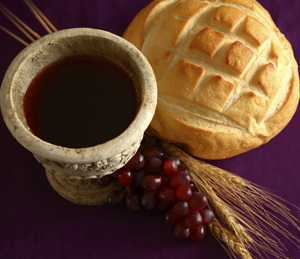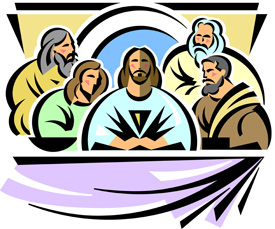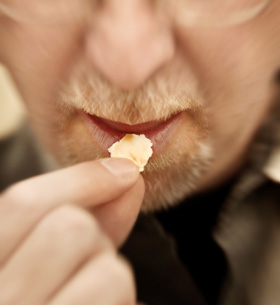We can’t drive very far before seeing a road sign giving us a warning or directions. Yield, One Way, and Stop Ahead signs are all intended to help us arrive at our destination safely. Although four-way Stop signs are designed to direct traffic and help us avoid collisions, they may also offer a spiritual picture as we gather to share in the Lord’s Supper. Four-way Stop signs direct us to look in all directions at an intersection, and the Bible offers similar instructions at the table.
We are directed to look inward: “Everyone ought to examine themselves before they eat of the bread and drink from the cup” (1 Corinthians 11:28). Looking inward at our spiritual condition opens our eyes to see our need for his grace.
We are instructed to look outward: “For those who eat and drink without discerning the body of Christ eat and drink judgment on themselves” (1 Corinthians 11:29). We are pointed to see the body of Christ and remember the needs and testimonies of those near to us.
We are told to look forward to Christ’s return: “I tell you, I will not drink from this fruit of the vine from now on until that day when I drink it new with you in my Father’s kingdom” (Matthew 26:29). Sharing in the Lord’s Supper reminds us a day is coming when we will join in the wedding feast of the Lamb and Jesus himself will be present.
And perhaps most importantly, we are told to look backward: “And he took bread, gave thanks and broke it, and gave it to them, saying, ‘This is my body given for you; do this in remembrance of me’” (Luke 22:19). The emblems of Christ’s body and blood are a visual reminder of his sacrifice on our behalf.
Just as four-way Stop signs urge us to look in all directions, the Lord’s Supper today admonishes us to see the eternal significance of this special meal and look inward, outward, forward, and backward. In this moment, our physical life intersects with a spiritual road that beckons us to stop and take a good look around. Which direction do you need to look today?
________________
Greg Swinney serves as ministry facilitator with Crossroads International Student Ministries, Kearney, Nebraska.













 For me, this is an uncomfortable arrangement. I look up and see strangers sitting at my table. Some clearly are of Indian ancestry, some British, some African, and all of them are enjoying fish and chips or bangers (sausages) and beans, happily oblivious to my discomfort. I try and remember to turn my fork upside-down and put it in my left hand before they notice I’m a Yank. I mean, who invited them to my table?
For me, this is an uncomfortable arrangement. I look up and see strangers sitting at my table. Some clearly are of Indian ancestry, some British, some African, and all of them are enjoying fish and chips or bangers (sausages) and beans, happily oblivious to my discomfort. I try and remember to turn my fork upside-down and put it in my left hand before they notice I’m a Yank. I mean, who invited them to my table? When Paul writes, “God made him who had no sin to be sin for us, so that in him we might become the righteousness of God” (2 Corinthians 5:21), he is describing a remarkable example of a look-alike serving as a stand-in. On the cross, human sinfulness was so thoroughly wrapped around Jesus that he looked thoroughly sinful. Jesus, as Peter observes, carried our sins in his body on the cross (1 Peter 2:24).
When Paul writes, “God made him who had no sin to be sin for us, so that in him we might become the righteousness of God” (2 Corinthians 5:21), he is describing a remarkable example of a look-alike serving as a stand-in. On the cross, human sinfulness was so thoroughly wrapped around Jesus that he looked thoroughly sinful. Jesus, as Peter observes, carried our sins in his body on the cross (1 Peter 2:24). Few of us give much thought to where our food is produced, or by whose hands and efforts it comes to our table. To us, a loaf of bread is just that. Although we may know better, we tend to think of it only in its completed, whole, and sliced-up form. One could almost imagine a great chugging piece of farm machinery, slowly making its way through a vast field of plastic-wrapped loaves of sliced sandwich bread.
Few of us give much thought to where our food is produced, or by whose hands and efforts it comes to our table. To us, a loaf of bread is just that. Although we may know better, we tend to think of it only in its completed, whole, and sliced-up form. One could almost imagine a great chugging piece of farm machinery, slowly making its way through a vast field of plastic-wrapped loaves of sliced sandwich bread.

